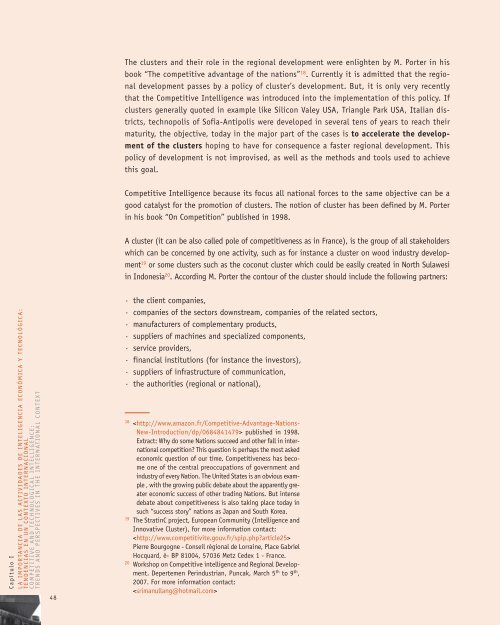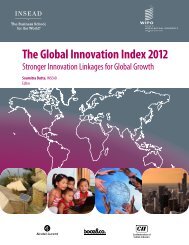intec
intec
intec
You also want an ePaper? Increase the reach of your titles
YUMPU automatically turns print PDFs into web optimized ePapers that Google loves.
Capítulo I<br />
LA IMPORTANCIA DE LAS ACTIVIDADES DE INTELIGENCIA ECONÓMICA Y TECNOLÓGICA:<br />
TENDENCIAS EN UN CONTEXTO INTERNACIONAL<br />
COMPETITIVE AND TECHNOLOGICAL INTELLIGENCE:<br />
TRENDS AND PERSPECTIVES IN THE INTERNATIONAL CONTEXT<br />
48<br />
The clusters and their role in the regional development were enlighten by M. Porter in his<br />
book “The competitive advantage of the nations” 18 . Currently it is admitted that the regional<br />
development passes by a policy of cluster’s development. But, it is only very recently<br />
that the Competitive Intelligence was introduced into the implementation of this policy. If<br />
clusters generally quoted in example like Silicon Valey USA, Triangle Park USA, Italian districts,<br />
technopolis of Sofia-Antipolis were developed in several tens of years to reach their<br />
maturity, the objective, today in the major part of the cases is to accelerate the development<br />
of the clusters hoping to have for consequence a faster regional development. This<br />
policy of development is not improvised, as well as the methods and tools used to achieve<br />
this goal.<br />
Competitive Intelligence because its focus all national forces to the same objective can be a<br />
good catalyst for the promotion of clusters. The notion of cluster has been defined by M. Porter<br />
in his book “On Competition” published in 1998.<br />
A cluster (it can be also called pole of competitiveness as in France), is the group of all stakeholders<br />
which can be concerned by one activity, such as for instance a cluster on wood industry development<br />
19 or some clusters such as the coconut cluster which could be easily created in North Sulawesi<br />
in Indonesia 20 . According M. Porter the contour of the cluster should include the following partners:<br />
· the client companies,<br />
· companies of the sectors downstream, companies of the related sectors,<br />
· manufacturers of complementary products,<br />
· suppliers of machines and specialized components,<br />
· service providers,<br />
· financial institutions (for instance the investors),<br />
· suppliers of infrastructure of communication,<br />
· the authorities (regional or national),<br />
18 published in 1998.<br />
Extract: Why do some Nations succeed and other fall in international<br />
competition? This question is perhaps the most asked<br />
economic question of our time. Competitiveness has become<br />
one of the central preoccupations of government and<br />
industry of every Nation. The United States is an obvious example<br />
, with the growing public debate about the apparently greater<br />
economic success of other trading Nations. But intense<br />
debate about competitiveness is also taking place today in<br />
such “success story” nations as Japan and South Korea.<br />
19 The StratinC project, European Community (Intelligence and<br />
Innovative Cluster), for more information contact:<br />
<br />
Pierre Bourgogne - Conseil régional de Lorraine, Place Gabriel<br />
Hocquard, è- BP 81004, 57036 Metz Cedex 1 - France.<br />
20 Workshop on Competitive intelligence and Regional Development.<br />
Depertemen Perindustrian, Puncak, March 5 th to 9 th ,<br />
2007. For more information contact:<br />






